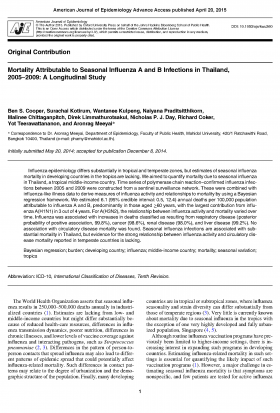This website uses cookies so that we can provide you with the best user experience possible. Cookie information is stored in your browser and performs functions such as recognising you when you return to our website and helping our team to understand which sections of the website you find most interesting and useful.
Mortality Attributable to Seasonal Influenza A and B Infections in Thailand, 2005–2009: A Longitudinal Study (2015)

รายละเอียดเพิ่มเติม
Ben S. Cooper, Surachai Kotirum, Wantanee Kulpeng, Naiyana Praditsitthikorn, Malinee Chittaganpitch, Direk Limmathurotsakul, Nicholas P. J. Day, Richard Coker, Yot Teerawattananon, and Aronrag Meeyai*
* Correspondence to Dr. Aronrag Meeyai, Department of Epidemiology, Faculty of Public Health, Mahidol University, 420/1 Ratchawithi Road, Bangkok 10400, Thailand (e-mail: [email protected]).
Influenza epidemiology differs substantially in tropical and temperate zones, but estimates of seasonal influenza mortality in developing countries in the tropics are lacking.We aimed to quantify mortality due to seasonal influenza
in Thailand, a tropical middle-income country. Time series of polymerase chain reaction–confirmed influenza infections between 2005 and 2009 were constructed from a sentinel surveillance network. These were combined with
influenza-like illness data to derive measures of influenza activity and relationships to mortality by using a Bayesian regression framework. We estimated 6.1 (95% credible interval: 0.5, 12.4) annual deaths per 100,000 population
attributable to influenza A and B, predominantly in those aged ≥60 years, with the largest contribution from influenza A(H1N1) in 3 out of 4 years. For A(H3N2), the relationship between influenza activity and mortality varied over
time. Influenza was associated with increases in deaths classified as resulting from respiratory disease (posterior probability of positive association, 99.8%), cancer (98.6%), renal disease (98.0%), and liver disease (99.2%). No
association with circulatory disease mortality was found. Seasonal influenza infections are associated with substantial mortality in Thailand, but evidence for the strong relationship between influenza activity and circulatory disease
mortality reported in temperate countries is lacking.
Full text can be accessed from:
http://www.ncbi.nlm.nih.gov/pubmed/25899091




